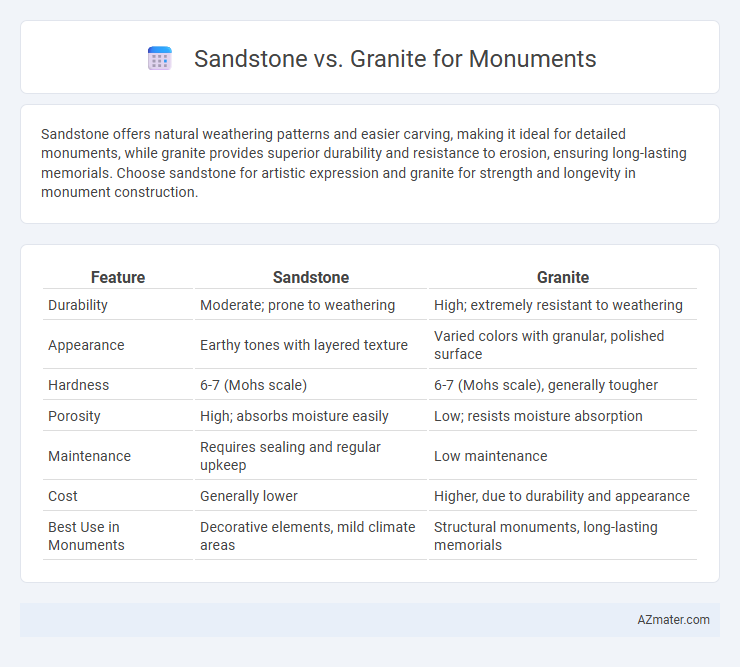Sandstone offers natural weathering patterns and easier carving, making it ideal for detailed monuments, while granite provides superior durability and resistance to erosion, ensuring long-lasting memorials. Choose sandstone for artistic expression and granite for strength and longevity in monument construction.
Table of Comparison
| Feature | Sandstone | Granite |
|---|---|---|
| Durability | Moderate; prone to weathering | High; extremely resistant to weathering |
| Appearance | Earthy tones with layered texture | Varied colors with granular, polished surface |
| Hardness | 6-7 (Mohs scale) | 6-7 (Mohs scale), generally tougher |
| Porosity | High; absorbs moisture easily | Low; resists moisture absorption |
| Maintenance | Requires sealing and regular upkeep | Low maintenance |
| Cost | Generally lower | Higher, due to durability and appearance |
| Best Use in Monuments | Decorative elements, mild climate areas | Structural monuments, long-lasting memorials |
Introduction to Sandstone and Granite Monuments
Sandstone monuments, composed primarily of quartz and feldspar, offer a natural, earthy texture ideal for intricate carvings and weathered aesthetics, making them a popular choice for historical and commemorative structures. Granite monuments, renowned for their exceptional durability and resistance to erosion, consist mainly of quartz, mica, and feldspar, providing a polished, enduring finish suited for modern memorials and high-traffic outdoor settings. Selecting between sandstone and granite depends on factors such as desired visual appeal, longevity, and environmental exposure of the monument site.
Composition and Geological Formation
Sandstone, primarily composed of compacted quartz and feldspar grains, forms through sedimentation and lithification of sand-sized minerals, often in ancient river or beach environments. Granite consists mainly of interlocking crystals of quartz, feldspar, and mica, crystallized slowly from molten magma deep within the Earth's crust. The coarse-grained texture and igneous origin of granite contribute to its superior durability compared to the sedimentary and relatively softer sandstone, influencing their use in monuments.
Visual Appeal: Color and Texture Comparison
Sandstone offers a warm, earthy palette with colors ranging from beige and tan to rust and red, featuring a naturally layered, coarse texture that enhances monument depth and character. Granite provides a broader color spectrum including black, white, pink, and grey, coupled with a smooth, polished surface that captures light and adds a refined, durable finish to monuments. The choice between sandstone and granite for monuments depends on the desired visual impact--rustic and organic with sandstone or sleek and enduring with granite.
Durability and Weather Resistance
Granite exhibits superior durability and weather resistance compared to sandstone, making it the preferred choice for long-lasting monuments exposed to harsh environmental conditions. Its dense crystalline structure resists erosion, frost damage, and chemical weathering more effectively than sandstone's porous composition. Sandstone may require regular maintenance to prevent surface degradation, while granite maintains structural integrity and appearance over centuries.
Maintenance and Longevity
Granite monuments offer superior longevity and require minimal maintenance due to their dense, hard composition, resisting weathering and erosion effectively over decades. Sandstone, while visually appealing with its natural textures, tends to be more porous and susceptible to weather damage, necessitating more frequent cleaning and protective sealing to preserve inscriptions and surface details. Choosing granite ensures a durable, low-maintenance monument ideal for long-term memorials, whereas sandstone may demand higher upkeep efforts to maintain its aesthetic integrity.
Carving and Customization Potential
Sandstone offers excellent carving and customization potential due to its softer texture, allowing intricate details and elaborate designs for monuments. Granite, being much harder and denser, requires advanced tools and skills, making intricate carvings more challenging but provides greater durability and resistance to weathering. The choice between sandstone and granite depends on balancing detailed artistry needs with long-term monument preservation.
Cost Differences and Value for Money
Sandstone typically costs less than granite for monuments due to its abundance and easier quarrying process, making it a budget-friendly option for projects with cost constraints. Granite offers higher durability, weather resistance, and a polished finish that enhances long-term value despite its higher initial price. Investing in granite ensures lower maintenance expenses and preserves monument aesthetics over time, delivering greater value for money in the long run.
Environmental Impact and Sustainability
Granite's dense composition and slower erosion rate make it a more environmentally sustainable choice for monuments, as it requires less frequent replacement and maintenance compared to sandstone. Sandstone, being more porous, may degrade faster in harsh weather conditions, leading to increased quarrying and resource consumption over time. Choosing granite reduces the overall ecological footprint by minimizing the demand for new materials and preserving natural landscapes.
Popular Uses in Monument Design
Sandstone is favored in monument design for its ease of carving and warm, natural tones, making it ideal for intricate sculptures and historical markers. Granite stands out in popular use due to its exceptional durability, resistance to weathering, and polished finish, often chosen for headstones and large memorials. Both materials are prevalent in monument architecture, with sandstone preferred for detailed artistry and granite for long-lasting structural elements.
How to Choose: Sandstone vs Granite for Monuments
Choosing between sandstone and granite for monuments depends on durability, aesthetic, and environmental conditions. Granite offers superior hardness and weather resistance, making it ideal for long-lasting memorials in harsh climates, while sandstone provides a softer texture and warmer color palette suited for detailed carvings and gentler environments. Assessing monument location, weather exposure, and desired design intricacy guides the optimal selection between the two stones.

Infographic: Sandstone vs Granite for Monument
 azmater.com
azmater.com